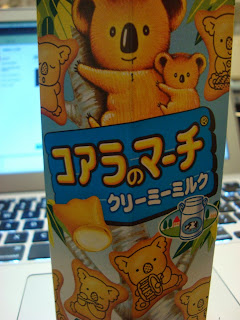(A) Sample 1
This is a dictionary of Japanese writers' pen names. As "pen name" is a foreign word, katakana is used here-"ペンネーム." Also, アニメis a foreign word "animation." And Katakana is used. I choose the page about "手塚治虫" who is the creator of アトム. Noticing that "アトム" is in Katakana, I think maybe the writer wants to emphasize アトム's importance as he is the hero of the comic book. Maybe he wants to show the sound of his hero's name and makes アトム be special.Generally, I think this アトムis the author's preference.
(B) Sample 2
This is a box of biscuits. All biscuits are in shape of koala. It tastes really good but expensive. I bought it in the M2M market near Columbia University. There are some Katakana on the box. First, the katakana "コアラ" describes the foreign word "koala." Second, “マーチ” describes the English word "match"in music. Thus, this is still a foreign word. Third, "クリーミーミルク" describe the foreign words "creamy milk." I think "creamy milk" is translation of English, thus here "milk" is not in its hiragana form "ぎゅうにゅう". Does this mean that katakana which is used to describe foreign words occupies a large proportion? Also maybe Katakana used in ads seems to be more fashionable and western-toward, as the words on box are translated words. As this product's market's target may be children, kanji is not used here.
(C) Sample 3
グミis soft candies. This word came from a Germany word. According to wikipedia, "名称はドイツ語でゴムを意味するGummiに由来する." Katakana here is just to mark the pronunciation of the Germany word "Gummibär." Also maybe katakana which is used here is to emphasize, because this is a brand and tries to catch people's attention. "マンゴスチン" just describes the foreign word mangosteen which is a kind of fruit. Or maybe this katakana word can be explained by using the explanation that "to write the name of an animal, plant, disease, tool,etc. (Applies mainly where pertinent kanji are not included in the Joo-yoo-Kanji list)" (On Katakana).



